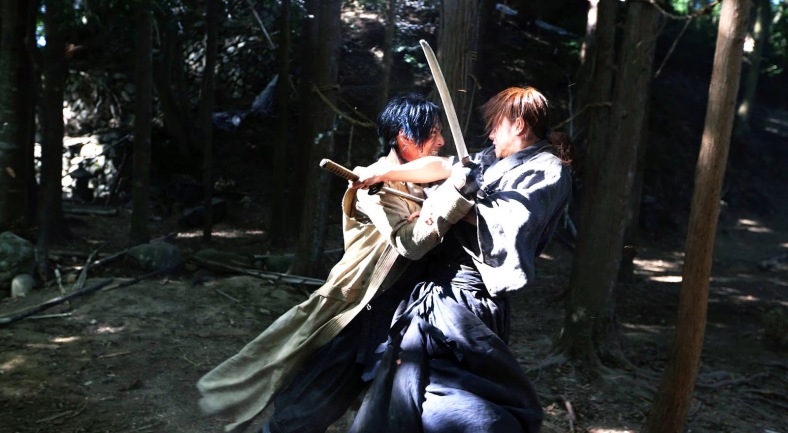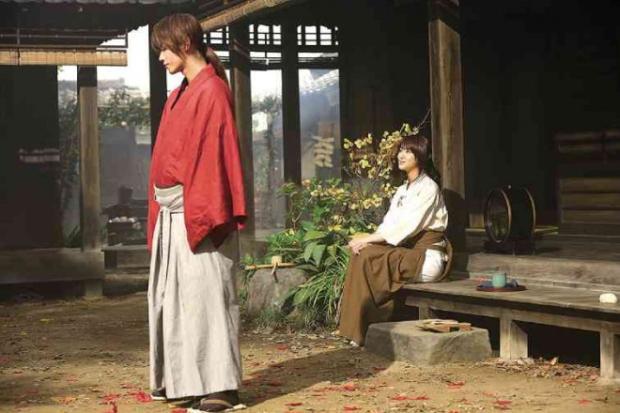All good things come to an end, they say. The prompt answer to this is “BUT WHY??”, but somehow, director Keishi Otomo, the legend Takeru Satoh and crew were able to give good, reassuring reasons as Battousai says goodbye.
From the very title of the film, Rurouni Kenshin: The Legend Ends had distinct words of finality, no matter how much fans wanted to deny it. As the movies from the franchise kept coming out better and stronger than the last, it was hard to accept an end to such deliciously addictive samurai live action/full on manga geek franchise. But separation anxiety aside, Otomo and Satoh’s dream team delivered a worthy denoument. Let’s break it down.
The stupid apprentice and his master. Kyoto Inferno ended with an unpredictable cliffhanger, specially for our hero who opens the scene by waking up from a three-day coma, fire tresses in disarray, sakabatō clutched in hand. Kenshin Himura (Satoh) rushes out of this unknown hut to the sight of his master Hiko Seijuro (Masaharu Fukuyama), and the jarring knowledge that his “love suicide” seemed to have actually ended in death. He did not save Kaoru (Emi Takei), he did not destroy Shishio (Tatsuya Fujiwara), and he was in the middle of nowhere with a master who was not too pleased to see him. It felt like a good time to drop on his knees in defeat.
Good thing Hiko was there to hit his head with a stick, literally, and several times at that. In the manga, Hiten Mitsurugi Master Hiko was the person hardest on Kenshin, but only second to Kenshin himself. Fukuyama, that great hulking man of an idol that he is, cut the impressive figure, playing to the hilt the role of not only Kenshin’s sword master, but the only father figure he ever had. He delivered truths as hard as his blows, revealing his idiot disciple’s vulnerabilities and helping him become stronger all the more by overcoming them. It was the first time we see the legendary Battousai second guess his own strength and nearly crumple in defeat at the possibility of death; and it made his claim to Hiten Mitsurugi‘s greatest secret even more victorious.
The beach. Elsewhere, Kaoru has been rescued (of course!) by friendly fisher folk of her own. They were not loner sword masters however, so they took the half-drowned girl to a hospital since that was the normal thing to do. She wakes up days later, unaware of the doting attentions of Sano (Munetaka Aoki) and Yahiko (Kaito Oyagi), and wanders off into the beach.
The promotional picture in this setting has been floating around in the weeks leading to the film, only to be missing when the movie finally rolled. Director Otomo in an interview said that he thought Kenshin would not have had time to visit Kaoru before his urgent call to Shishio. Purists (boys) would probably agree, but I believe otherwise. Apart from the sheer understated romance of it, I felt that a short talk with Kaoru prior to the biggest battle of his life would be imperative to Kenshin. Kaoru was the personification of his conscience, his companion (romantic and beyond) in this pacifist life he was trying to succeed in. An affirmation of his purpose, of an end to his suffering, of a home waiting for him — these things are just as important as that heart-shattering goodbye he did in Tokyo when he thought he had to give them all up.
But that’s just me. I guess I can wait for the extended scenes in the DVD box set.
On that sad note, the luminous Takei was relegated to a smaller role in this film. Robbed of what would have been a key scene, she and Yahiko took to running helplessly after Kenshin among the mob, then running helplessly after him when he boarded the warship (Yahiko even had a bigger role, being the better of Sano when both Kenshin and Kaoru were missing). She regained her purpose when Kenshin returns, damaged but whole, and acts as his human crutch, bringing him home as promised.

Aoshi vs Kenshin. Winner of Battle Scene Most Deserving of a Rewind. (Rurouni Kenshin: The Legend Ends)
Aoshi emancipated. Everyone’s key beef with the second film was the sad underdevelopment of Aoishi Shinomori’s character and the Oniwabanshu story line. Reduced to a mad man whose only line was “Where is Battosai?”, Aoishi (Yusuke Iseya) made up with an epic tree-slicing battle what he lacked so sorely in terms of plot and character development. Although Kenshin would have more grandiose battles scene ahead of him, this slice-and-dice with Aoshi was pivotal on several aspects. For one, this is the first time in the film we see the legend return, renewed from his training with Hiko and with Amakekeru under his sleeve. I think the movie Aoshi could not have picked a worse time to have finally met Battosai; rather than giving Kenshin a fight for his life, Aoshi just volunteered to be a practice session. But it was a fierce one at that! If I had to pick one single fight scene to rewind several times in this film, this would be it.
Theatrics and politics. I guess it was naive of me to have clung to the hopes that the films would be a blow-by-blow retelling of the manga. As we moved from the first movie to Kyoto Inferno, Otomo has taken liberties from the material, but he did so the most in this final chapter. Here we see Shishio move his theatrics from his home base to the front door of the Japanese government, directly issuing a demand for Kenshin’s head via public execution. This pivot is what I believe allowed for more holes in the plot than were easy to dismiss. But it also shifted the wave of antagonism from Shishio to the new regime, emphasizing that the politicians are not as clean and dignified as they believe themselves to be. It also put in relief that Kenshin was neither breed of megalomania – he was purely a pacifist who just so happened to be talented in violence.
The boy and the man. The weak and the strong. Kenshin’s round two bout with Sojiro Seta was one of many fight scenes that I felt was too short (nothing was as short as Sato Hajime and Usui’s one-gatotsu kill, but a movie can’t breach 3 hours I guess). But at least I was spared the pain of seeing Kenshin get good and sliced as he battled this young’un. The fight played out in a corridor-wide space of metal sheets and wood planks, with the epicene boys harnessing both speed and accuracy. It was short but sweet, specially on that moment when Kenshin returned the favor of breaking Sojiro’s sword. And bow.
Notice me senpai. The five-man battle. I can’t say I was looking forward to this scene, because Shishio scared the hell (pun intended) out of me and because I know Otomo was sure to put the shoulder-biting part in the movie (because really, who wouldn’t?). Many would have argued against the bits where Otomo decided to digress from the manga, but he sure did know when to stick with it. This epic five-man battle was lifted nearly page by page from the comics, and if you never thought you can imagine how five people can engage in battle all at once (with one of them not even wielding a sword), well this movie will show you in both close angles and sweeping views. Though I could not help a snicker every time Shisio bellowed “who are you??” to Sano and Aoishi, that was all I could do to break the tension.
When the katana-bullets were released and with Yumi skewered and dead on the floor, the crowded setting was reduced to only the two retired assassins. Spent and bleeding just like his opponent, I have lost all hope that Kenshin could draw the strength to deliver his Amakakeru Ryu No Hirameki. But deliver it, he did. Shishio, the arrogant bastard that he is, crumpled but still stood up long enough so he can be defeated in his own terms, devoured in his own flames.
REWIND.
A maple leaf promise. As the movie winds down, we know that Hiko has fulfilled his promise. Battousai is dead, but much like the madman Shishio, he died in his own terms, and now all that is left is Himura Kenshin. Rid of the shadows of his past, Kenshin has renewed his life’s purpose. He is now free to allow himself to be happy, and to make promises he can keep.
The legend has ended.
P.S. I still cling on to hope of the Jinchu arc coming to life in the big screen too. I hope Warner Brothers Japan can make a promise on that as well! Gambatte!
Photo and video credits to owners.








amadl
October 20, 2014 at 1:11 amGreat review, and I agree with you but one: the movie can breach 3 hours if it has to because it has more materiaLs to cover than LOTR The Return of The King.
And yes, Let’s hope for Jinchuu arc adaptation!
thisismyfireexit
October 23, 2014 at 9:55 pmWow I didn’t think to compare to LOTR! But you’re right! Though the Japanese are quite known to like their movies/dramas concise. Jinchuuuuu!!! *cross fingers*
Review: Lupin III | Daydreaming since 1985. Sometimes with actual results.
December 8, 2014 at 9:41 am[…] it is because I watched Lupin III in the midst of the sheer glory of the Rurouni Kenshin trilogy. Maybe it is because I haven’t met a multi-language movie that I liked. Or maybe […]